~Enrich your culinary experience with the right tools.~
In all cuisine, the way ingredients are cut is crucial in bringing out their full potential. Using a dull knife can cause the tissue to collapse, resulting in a loss of flavor and ruining the entire dish. On the other hand, cutting ingredients properly can dramatically improve the dish.
At Hamonoya-Sanshodo, we are dedicated to providing you with special knives that deliver surprise and excitement through their sharpness and craftsmanship.
Let us help you take your cooking to the next level with our full support.

・Seki City, Gifu Prefecture
・Echizen City, Fukui Prefecture
・Sakai City, Osaka Prefecture
・Miki City, Hyogo Prefecture
・Sanjo City, Niigata Prefecture
-

Petty Knife, Made by Seiki, VG10 Steel, Red Plywood Handle, 150mm(ペティ 誠貴作 V金10号 赤合板 150mm)
¥17,500($113.75)
This is a Petty Knife from Tanaka Kazuyuki Cutlery Manufacturing in Miki City, Hyogo Prefecture. It's a unique Petty Knife that you won't find anywhere else. Product Information Description of the Blade Origin: Miki City, Hyogo Prefecture (Banshu Miki Uchihamono) Category: Petty Blade length: 150mm Steel material: VG10 Steel Structure: Layered structure Made by Tanaka Kazuyuki Cutlery Manufacturing in Miki City, Hyogo Prefecture, this Petty Knife is not only sharp but also uniquely distinctive, offering an originality not seen in other knives. A standout feature is its layered structure, where thin slices of hard stainless steel, designed for sharp cutting, are sandwiched in a mille-feuille style. Sharpening these layers creates a beautiful wave pattern on the blade. Furthermore, since each knife is individually sharpened by artisans, no two knives have the exact same pattern, making each one a unique piece in the world.
-

Petty Sai Damascus finish Micarta pattern with clasp 150mm(ペティ サイ ダマスカス仕上げ マイカルタ柄 口金付 150mm)
¥12,400($80.60)
Cutlery description Production area: Echizen City, Fukui Prefecture (Echizen Cutlery) Classification: Small Knife Blade elongated: 150mm Steel material: Laminated steel Pattern: My chart handle with mouthkill (By sticking with the mouthpiece, dirt is difficult to accumulate at the boundary between the blade and the handle where dirt tends to accumulate, and can be used hygienically) Damascus steel is well known in the knife world. It is popular for its wood grain-like patterns, and missing items It has come out one after another. Damascus steel is bladed by coating some thin steel material in a mille-feuille shape. This has been the mechanism by which wood grain patterning can be carried out. Damascus steel itself is a steel material made in ancient India, and the cutlery currently in circulation is As "Damascus finished" and "Damascus pattern", we sell things similar to the image of Damascus steel. Much of this bullion was made by steel manufacturers, and in rare cases blacksmiths made similar forges. Difficult to understand are "damascus finished", "ink sink", "forged" and "laminated steel" by kitchen knife manufacturers. Since it's an expression, please think that it's basically the same friend.
-

Petty TAMAHAGANE Bamboo Kyoto Damascus 150mm(ペティ TAMAHAGANE 竹 響十 ダマスカス 150mm)
¥19,300($125.45)
Cutlery description Production area: Sanjo City, Niigata Prefecture (Sanjo Cutlery) Classification: Small Knife Blade elongated: 150mm Steel: Damascus Steel (63 ply) Pattern: Mohawk Handle (Handle part is hollowed out and adopts "monaca stainless structure" which is light in weight and keeps beauty forever.) In addition, it is a hygienic handle which allows cleaning of water, detergent, etc. high pressure and high temperature using 18-8 stainless steel. * Do not use hypochlorous acid, chlorine, etc. sterilizer. ) Damascus steel is made from Indian woots and forged into swords and other swords in Damascus, Syria. Its biggest feature is the unique pattern that occurs when molten cast steel is solidified in the crucible, and very few people know the method of manufacture. During the Crusades, it was prized as a famous sword for its mysterious beauty and value. It is present that Damascus steel has reproduced this pattern.



